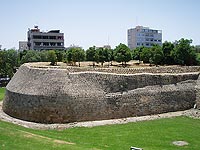
Ottoman period in the history of Nicosia, Cyprus.
 |
the north cyprus travel guide |
 |
|
Nicosia History Ottoman Period
The Ottoman invasion of 1571 came as a welcome relief for many people living on Cyprus; they were at last free of their Venetian overlords. However, there were two cites that resisted the invaders, the walled cities of Famagusta and Nicosia. Their legacy of resistance helped from the cities you see today on your North Cyprus holiday, their massive defensive walls visible from the skies as you fly in on your flight to North Cyprus. Ottoman Cyprus: Nicosia FallsDespite fierce opposition, the Ottomans took both cites, and once inside Nicosia, the Turks took their revenge on the Nicosians for the seven weeks of hard fighting the city had cost them. However, they also did what the Ottomans did best, to assimilate the best of what already existed, and start a programme of public works to bring the city back to life. It is said that the invasion of Cyprus took place because the Sultan of the time, Selim II, simply adored Cypriot wine. (See if it has the same effect on you during your holiday in Northern Cyprus!) In fact, the island’s Venetian rulers were the main competitors for the Ottoman’s bid for dominance in this part of the Mediterranean. The biggest obstacles to the Ottoman invasion plans were not the defensive walls of the island’s cities, but the massive defensive fleet that lay between the invaders and their goal. In October 1571, almost the entire Ottoman fleet was destroyed, but the Turks held on to Cyprus itself - just.
Ottoman North Nicosia: Churches and MosquesThe Ottoman rulers were happy to recognise the Orthodox Church and restore the archbishopric. (They then used the church to collect taxes, a smart move!) However, they were not so forgiving of the Catholic church, linked as it was to the Venetian rulers. The Catholic leaders were expelled, and the population given the choice of conversion to the Orthodox faith, or to Islam. Many Catholic churches in Nicosia were converted to mosques after 1571, including the former cathedral of St Sophia and the church of S Catherine, both of which you can still visit today on your holiday to Nicosia in North Cyprus. Ottoman North Nicosia: Baths and FountainsThe Ottoman invaders had a different view of celebrating their successes; instead of vast monuments, they preferred to show their status by a programme of improvements and public works. North Nicosia in Northern Cyprus today is full of these great Ottoman improvements, from the Great Inn to the octagonal water fountains on every street corner, which supplied clean drinking water for the entire population. They also introduced public bath houses, the most famous of which in North Nicosia is the Great Bath, housed in the shell of a 14th century church. (This working bath house is a great place for a relaxing Turkish bath experience, and much more authentic than most North Cyprus hotel spas! Make sure you allow time for a visit during your North Cyprus holiday.) The Ottomans also encouraged their own Turkish people to settle on the island; many of their won invading army remained in North Cyprus, and were joined by skilled craftsmen from the mainland, until there were around 30,000 Muslim Turks in Cyprus. The Ottoman rulers would soon need all this population growth to survive. Between 1625 and 1700, a combination of economic stagnation and plague severely reduced the population across the whole of the island of Cyprus. Indeed, in 1639, there were 150,00 people living in Cyprus, down to just 25,000 two years later. Try to imagine just 25,000 people on the whole of Cyprus as you look out of the window on your flight to North Cyprus – there are probably more than 25,000 swimming pools in North Cyprus alone! Ottoman North Nicosia: The Beginning of the EndThe discovery of America and the popularity of trade with the New World ensured that the trade dominance of the Mediterranean faded away. Even so, despite the stiff competition, cotton growing thrived in Cyprus and the island maintained its reputation for fine linens, embroidery. Nicosia was known for its fine silk and gold thread embroidery work. (Look out for them as you tour the bazaars of modern North Nicosia on your North Cyprus vacation.) Whilst the Ottoman governor, or pasha, was supposedly in charge, the community posts of tax collectors and church leaders were extremely also powerful. In 1660, the Greek Cypriot church leaders were recognised as the representatives of their people, and in 1754 the archbishopric was given responsibility for collecting taxes. By the early 1800s, the bishop was almost more powerful than the governor himself. In 1821, the Greek-speaking areas of the Ottoman empire revolted against their masters, but the Ottoman governor of Cyprus came down hard on the rebels in Nicosia. The Greek Cypriots were crushed, unable to join the rebellion, and the seeds of the desire for unity with Greece were sown. In 1830, the Sultan Madmud II made new rules to help reform the empire, but few were ever put into practice. Instead, the empire began to disintegrate, until the British annexed Cyprus as a "place of arms", in order to "protect" the Ottoman empire from the Russian threat. In effect, the Ottoman empire was over, and in 1925 Cyprus became a British Crown colony. |
|
North Cyprus quick: holidays | flights | hotels | property | kyrenia | famagusta | photos | map | weather | history | news
All text is copyrighted by Cyprus44. Photographs are copyrighted by their respective photographers.
For more information read our copyright policy, privacy policy and disclaimer.
This web page is served on 16 September 2025 at 8:28:03 PM.
![]()
Cyprus44 in other languages: Nordzypern | Chypre Nord | Severní Kypr | Северный Кипр
partner sites: goNorthCyprus Travel | Pacific Rent-A-Car | Amy Holiday Villas | other partner sites








